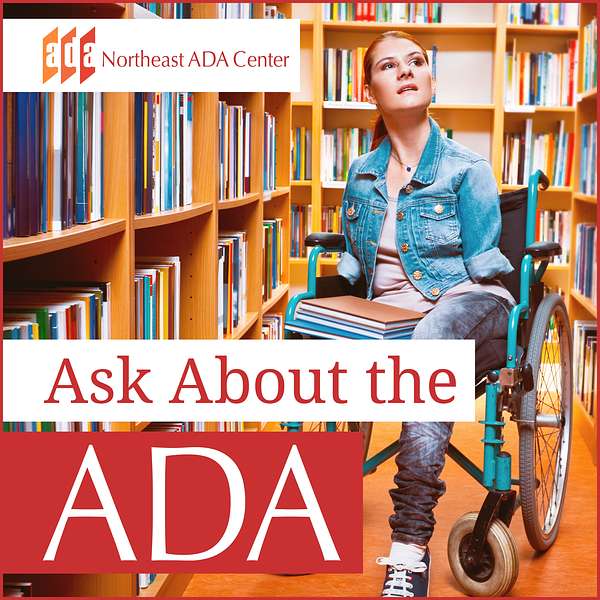
Ask About the ADA Podcast
The podcast answers frequently asked questions about the Americans with Disabilities Act and explores the rights and responsibilities of people with disabilities under the law.
Ask About the ADA Podcast
Ask About: Challenging Transit
•
Northeast ADA Center
•
Season 1
•
Episode 14
What happens when an elevator breaks in a transit station? Can transportation service providers deny service based on wheelchair weight? This edition of Ask About the ADA is about some special situations in transit accessibility. For a transcript of today's episode, please visit the Ask About the ADA podcast feed on BuzzSprout.
Read more about transit station accessibility and transit wheelchair weight standards.
NortheastADA.org
JOE ZESSKI: Hello, and welcome to this edition of Ask About the ADA, the podcast where we answer frequently asked questions about the Americans with Disabilities Act and other disability-related topics that we receive at the Northeast ADA Center. On this edition, we have two questions that focus on different areas of transportation and access. So that being said, let's dive right into things. [MUSIC PLAYING] Our first question is about accessing train stations and bus stations. If a transportation station has an elevator that breaks down, do the ADA regulations address what should be done to accommodate riders with disabilities? The ADA regulations require that transit agencies take reasonable steps to accommodate individuals who would otherwise be able to use the accessibility feature, which, of course, in this case is the elevators. That being said, the regulations don't state exactly how this should be done. But whatever a transit agency decides to do, it has to be effective. In other words, it has to meet the need and notify the individuals with disabilities who would otherwise use the elevator that this is a problem. So for example, the agency could notify users of that particular station that there's an issue by making announcements at other stations so that when they are on the transit system, they know that if I get off at this station, the elevator won't be working. Likewise, a transit agency could post it on its website in addition to making the in-station announcements, in other words, making sure that individuals know that there is a problem with the elevator that needs to be addressed. In addition to this, an alternate means of accessibility should be offered. For example, this might involve the use of an accessible shuttle bus to transport passengers with disabilities around the station with the affected elevator, the elevator that's out of service. It's always important to keep in mind as well above and beyond what we touched on so far that temporary outages are not in and of themselves a violation of the ADA. However, the clear expectation is that accessible features like an elevator are frequently inspected and kept in good working operational condition and, if there are any outages or interruptions in service, those are addressed quickly and promptly in order to make the accessible feature available again. [MUSIC PLAYING] Now let's look at our second question. Can a transit provider deny me service because my power wheelchair is too heavy? Well, with this question, we have to look at the regulations from the Department of Transportation. The DOT creates the regulations under the ADA that affect public transit. Their regulations require that transit agencies provide service to riders with disabilities who use wheelchairs. Now, regulations from the DOT specify minimum design requirements for lifts on transit vehicles. The lifts must be able to accommodate a weight up to 600 pounds. Now, that includes both the wheelchair and the occupant, the person in the wheelchair. In addition, the lift dimensions require that they accommodate chairs that are up to 30 inches wide and 48 inches long. Now, in addition to this, many of the lifts that are on public transit vehicles go beyond this standard. They can accommodate additional weight and space. A transportation agency or provider has to provide service to a rider with a disability that can be accommodated by the design of the lift on the particular public transit vehicle. So if a lift on a bus can accommodate 800 pounds capacity, if the individual's wheelchair such as a power wheelchair and the individual in it are less than that, they need to be accommodated even though the minimum requirement for a lift is only that it be able to handle 600 pounds. So again, it's about safe operation of the equipment as long as the minimum standards are met. Now, if an individual's combined weight for themselves and their wheelchair exceed the safe operating limit for the lift, then the transit provider does not have to provide service. They have met their obligations. [MUSIC PLAYING] So we covered some key transportation issues during today's podcast. If you have more questions about riding public buses, paratransit, or other transportation-related issues, please reach out to us at the Northeast ADA Center. You can contact us by phone at 1-800-949-4232. You can email us at northeastada@cornell.edu, or visit us on the web at northeastada.org. Please feel free-- and I encourage you also-- to follow us on social media. Just look for @northeastada on Facebook, on Instagram, on Twitter, all the platforms that are out there. Finally, I also would like to thank all those who made today's show possible. Thank you to Grace Fairchild, our student worker who does our editing as well as produces the show. Thank you as well to Peter Quinn of the Yang-Tan Institute's media team for doing additional edits on today's show. And thank you to Jennifer Perry, our access specialist who wrote today's questions. I am Joe Zesski, the program manager at the Northeast ADA Center. And I hope you'll be back to listen for more. And let's continue the conversation. [MUSIC PLAYING]